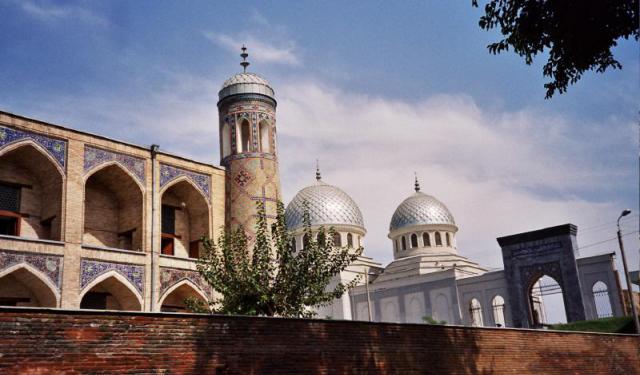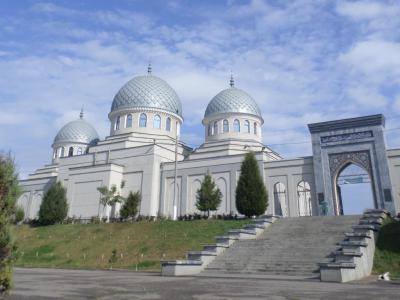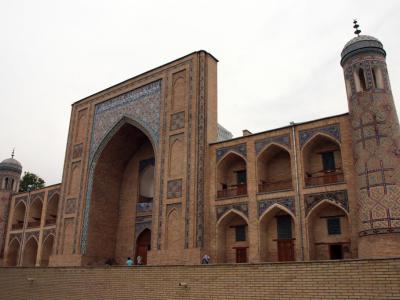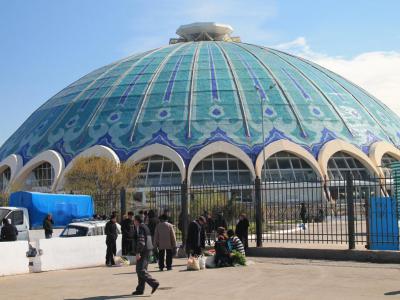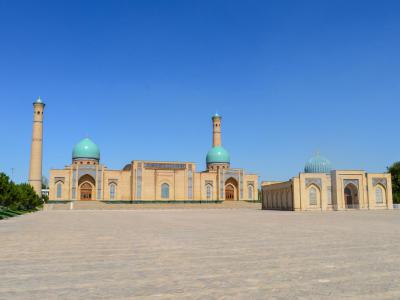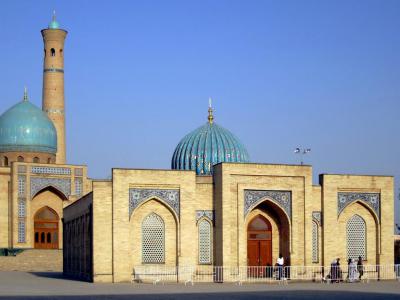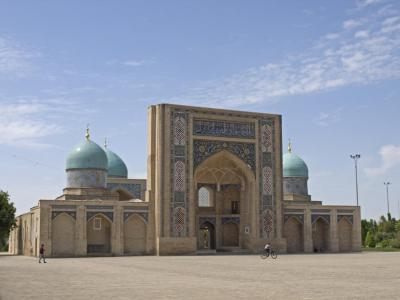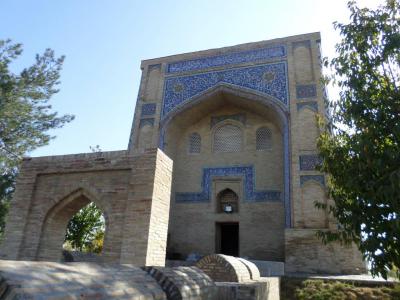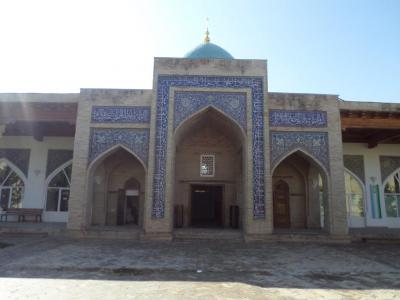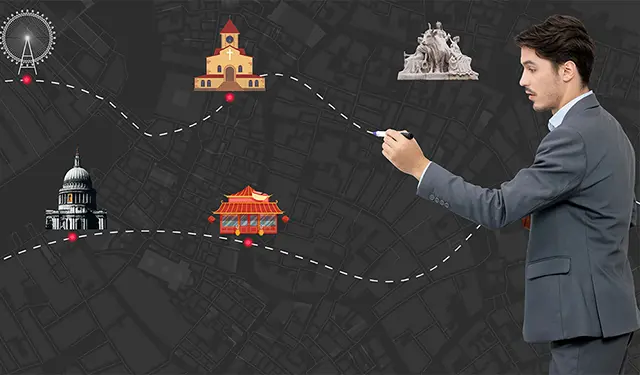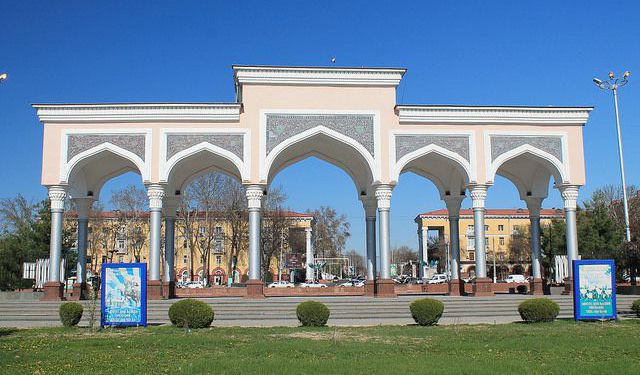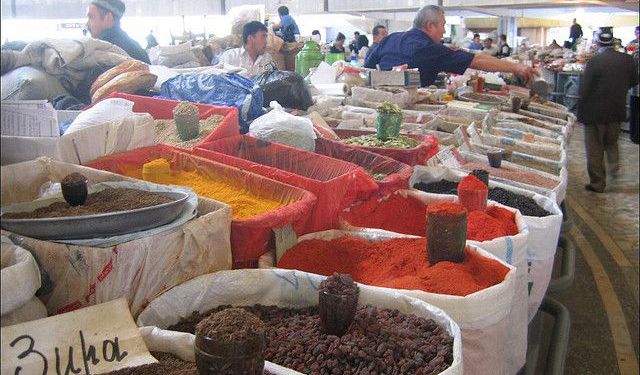Islamic Architecture Walking Tour (Self Guided), Tashkent
A visit to Uzbekistan is like leafing through the charred chapters of the Silk Road. Nowhere is this ambiance more exemplified than within the Islamic architecture adorning the streets of Tashkent.
One such architectural jewel is the Kukeldash Madrasah, dating back to the late 16th century. There is talk of making it into a museum, but it is currently still being used as a religious school.
Located near is the famous Chorsu Bazaar. This huge open-air market is the center of the old town of Tashkent. Everything imaginable is for sale here, from the daily groceries to ceramics, national costumes, and tubeteika caps. And it is one of the major tourist attractions in the city.
Another notable site is the Hazrati Imam Complex. The construction of this religious ensemble was completed in 2007; it consists of the 16th-century Muyi Muborak Madrasah; Barak Khan Madrasah with two mausoleums Inside - the Mausoleum of Suyunchkhoja Khan, the burial place of the first ruler of Tashkent from the Uzbek Sheibanid dynasty, and the so-called Nameless mausoleum built for Barak Khan himself. The Mausoleum of Hazrati Imam (Kaffal Shoshiy) is yet another picturesque tomb built in honor of the 16th-century Islamic leader, Khazrat Imam (Abu Bakr ibn Ismail al-Kaffal ash-Shoshiy).
The Namazgokh Mosque and Islamic Institute are actually a one location, constructed in 1845-1865; it is now home to religious studies.
To discover tales behind the towering blue-topped minarets, as you delve deeper into the history of one of Central Asia's most exciting destinations, take this self-guided walking tour and find out some of the most interesting landmarks in the old part of Tashkent.
One such architectural jewel is the Kukeldash Madrasah, dating back to the late 16th century. There is talk of making it into a museum, but it is currently still being used as a religious school.
Located near is the famous Chorsu Bazaar. This huge open-air market is the center of the old town of Tashkent. Everything imaginable is for sale here, from the daily groceries to ceramics, national costumes, and tubeteika caps. And it is one of the major tourist attractions in the city.
Another notable site is the Hazrati Imam Complex. The construction of this religious ensemble was completed in 2007; it consists of the 16th-century Muyi Muborak Madrasah; Barak Khan Madrasah with two mausoleums Inside - the Mausoleum of Suyunchkhoja Khan, the burial place of the first ruler of Tashkent from the Uzbek Sheibanid dynasty, and the so-called Nameless mausoleum built for Barak Khan himself. The Mausoleum of Hazrati Imam (Kaffal Shoshiy) is yet another picturesque tomb built in honor of the 16th-century Islamic leader, Khazrat Imam (Abu Bakr ibn Ismail al-Kaffal ash-Shoshiy).
The Namazgokh Mosque and Islamic Institute are actually a one location, constructed in 1845-1865; it is now home to religious studies.
To discover tales behind the towering blue-topped minarets, as you delve deeper into the history of one of Central Asia's most exciting destinations, take this self-guided walking tour and find out some of the most interesting landmarks in the old part of Tashkent.
How it works: Download the app "GPSmyCity: Walks in 1K+ Cities" from Apple App Store or Google Play Store to your mobile phone or tablet. The app turns your mobile device into a personal tour guide and its built-in GPS navigation functions guide you from one tour stop to next. The app works offline, so no data plan is needed when traveling abroad.
Islamic Architecture Walking Tour Map
Guide Name: Islamic Architecture Walking Tour
Guide Location: Uzbekistan » Tashkent (See other walking tours in Tashkent)
Guide Type: Self-guided Walking Tour (Sightseeing)
# of Attractions: 8
Tour Duration: 2 Hour(s)
Travel Distance: 3.6 Km or 2.2 Miles
Author: DanaOffice
Sight(s) Featured in This Guide:
Guide Location: Uzbekistan » Tashkent (See other walking tours in Tashkent)
Guide Type: Self-guided Walking Tour (Sightseeing)
# of Attractions: 8
Tour Duration: 2 Hour(s)
Travel Distance: 3.6 Km or 2.2 Miles
Author: DanaOffice
Sight(s) Featured in This Guide:
- Jami Mosque (Friday Mosque)
- Kukeldash Madrasah
- Chorsu Bazaar
- Hazrati Imam Complex
- Muyi Muborak and Tilla Shaikh Madrasah
- Barak Khan Madrasah
- Mausoleum of Hazrati Imam (Kaffal Shoshiy)
- Namazgokh Mosque and Islamic Institute
1) Jami Mosque (Friday Mosque)
Mosque Khoja Ahrar Vali or Jami Mosque is the basis of the Registan ensemble in the area of Chorsu square. The only Tashkent example of the Friday mosque of the yard type, common in Central Asia in the late Middle Ages.
The main building has the shape of a cube covered with a dome with four windows in a low cylinder. On the eastern wall, facing the courtyard, there is a large arch cut through. The border of arches and niches at the entrance is lancet, which is not typical for the Central Asian outline, rather Gothic. The layout of the mosque is rectangular with a large building at the end of the east-west longitudinal axis.
The first building of the Tashkent Juma Mosque (Uzb. Juma masjidi) (Main Friday Mosque) was built in 1451 at the expense of Sheikh Ubaydulla Khoja Akhrar (Uzbek Akhror ) (1404-1490).
Ubaydulla Ahrar, the great master of Sufism , the head of the Muslim clergy, in preparation for the move, ordered the construction of a large Friday mosque and madrasah in the ancient Tashkent mahalla Gulbazar. Local legends say that Ubaydulla got the money for the construction from the sale of “cutting threads”, which remain after cutting the fabric into standard pieces.
The main Friday mosque was built on a hill; therefore it was possible to see this majestic building from a great distance. From that time to the present day, people call this mosque, the mosque of Ubaydulla Ahror , in memory of him.
In 1868 the mosque was severely damaged by a devastating earthquake. By 1888, the Juma Mosque was repaired with the participation of Russian engineers. Funds for repairs, in the amount of 15,000 rubles, were taken from a gift from the Emir of Bukhara Muzaffar made to Emperor Alexander III on the occasion of his coronation in 1883 . The grand opening of the renovated Juma Mosque took place in July 1888.
In Soviet times, various state organizations were located here: the department of the Ministry of Education, other state institutions and even a cinema.
The last restoration of the Khoja Ahrar Vali Mosque was carried out in the 1990s. The building was recognized as emergency and it was completely rebuilt by modern architects, the cube was demolished, and instead of one dome, now there are three of them.
In 2003, the mosque was rebuilt on the same site using modern construction and decoration methods.
The main building has the shape of a cube covered with a dome with four windows in a low cylinder. On the eastern wall, facing the courtyard, there is a large arch cut through. The border of arches and niches at the entrance is lancet, which is not typical for the Central Asian outline, rather Gothic. The layout of the mosque is rectangular with a large building at the end of the east-west longitudinal axis.
The first building of the Tashkent Juma Mosque (Uzb. Juma masjidi) (Main Friday Mosque) was built in 1451 at the expense of Sheikh Ubaydulla Khoja Akhrar (Uzbek Akhror ) (1404-1490).
Ubaydulla Ahrar, the great master of Sufism , the head of the Muslim clergy, in preparation for the move, ordered the construction of a large Friday mosque and madrasah in the ancient Tashkent mahalla Gulbazar. Local legends say that Ubaydulla got the money for the construction from the sale of “cutting threads”, which remain after cutting the fabric into standard pieces.
The main Friday mosque was built on a hill; therefore it was possible to see this majestic building from a great distance. From that time to the present day, people call this mosque, the mosque of Ubaydulla Ahror , in memory of him.
In 1868 the mosque was severely damaged by a devastating earthquake. By 1888, the Juma Mosque was repaired with the participation of Russian engineers. Funds for repairs, in the amount of 15,000 rubles, were taken from a gift from the Emir of Bukhara Muzaffar made to Emperor Alexander III on the occasion of his coronation in 1883 . The grand opening of the renovated Juma Mosque took place in July 1888.
In Soviet times, various state organizations were located here: the department of the Ministry of Education, other state institutions and even a cinema.
The last restoration of the Khoja Ahrar Vali Mosque was carried out in the 1990s. The building was recognized as emergency and it was completely rebuilt by modern architects, the cube was demolished, and instead of one dome, now there are three of them.
In 2003, the mosque was rebuilt on the same site using modern construction and decoration methods.
2) Kukeldash Madrasah
The ancient Kukeldash madrasah (Islamic religious school) is the largest of the 23 madrasahs found in Tashkent. It is also one of the oldest in Central Asia, built circa 1570, under the Shaybani Dynasty. Back then, the area was the southern edge of the city, and the madrasah was set upon the remains of the rampart of the southern fortress with a moat (which is now a street).
Historically, the establishment of the school has been attributed to two famous individuals of that period, namely: Qulbobo Kokaldosh, the influential minister of the Sheybanid sultan Barak Khan, and the governor of Tashkent, Darvesh Khan, nicknamed "kukeldash", which means blood brother of the khan. The opinions, as to who exactly founded and built the school, vary.
Over the years, among those who studied here have been the likes of Furqat, an Uzbek author, poet, and political activist, in 1889-1891; and Hamza, another prominent author, composer, playwright, poet, scholar, and political activist, in 1910-1911.
The two-story yellow brick building is of traditional square shape, with a huge gate and inner yard. The actual walls surrounding the inner yard are the living quarters for students – two-story dormitories in the form of cells (“hujras”).
By the 1730s, the structure had fallen into disrepair and was converted to caravanserai, a roadside inn for caravaners. Following that, for a while, it served as a fortress. In 1830-1831, the first floor of the building was demolished, and the bricks were used to build the nearby Beklarbegi madrasah. It was later restored.
Several earthquakes, in 1868 and 1886, destroyed the façade, which was subsequently restored in 1902-1903. The building was reconstructed again, in the 1950s, following yet another devastating earthquake, in 1946, and was one of only few religious sites in Tashkent to survive the most recent, 1966 earthquake.
Throughout the 20th century, the building served as a museum, first of atheism, and later of folk music. In the 1990s it was made a madrasah again. As a result of numerous reconstructions, the appearance of the madrasah has changed. Despite that, it still remains a must-see attraction in Tashkent, known for its landmark gate, 20 meters (66 feet) high, flanked by two towers.
In 2008, on the occasion of the 2200th anniversary of Tashkent, the frontal part of Kukeldash received a fresh “facelift”.
Historically, the establishment of the school has been attributed to two famous individuals of that period, namely: Qulbobo Kokaldosh, the influential minister of the Sheybanid sultan Barak Khan, and the governor of Tashkent, Darvesh Khan, nicknamed "kukeldash", which means blood brother of the khan. The opinions, as to who exactly founded and built the school, vary.
Over the years, among those who studied here have been the likes of Furqat, an Uzbek author, poet, and political activist, in 1889-1891; and Hamza, another prominent author, composer, playwright, poet, scholar, and political activist, in 1910-1911.
The two-story yellow brick building is of traditional square shape, with a huge gate and inner yard. The actual walls surrounding the inner yard are the living quarters for students – two-story dormitories in the form of cells (“hujras”).
By the 1730s, the structure had fallen into disrepair and was converted to caravanserai, a roadside inn for caravaners. Following that, for a while, it served as a fortress. In 1830-1831, the first floor of the building was demolished, and the bricks were used to build the nearby Beklarbegi madrasah. It was later restored.
Several earthquakes, in 1868 and 1886, destroyed the façade, which was subsequently restored in 1902-1903. The building was reconstructed again, in the 1950s, following yet another devastating earthquake, in 1946, and was one of only few religious sites in Tashkent to survive the most recent, 1966 earthquake.
Throughout the 20th century, the building served as a museum, first of atheism, and later of folk music. In the 1990s it was made a madrasah again. As a result of numerous reconstructions, the appearance of the madrasah has changed. Despite that, it still remains a must-see attraction in Tashkent, known for its landmark gate, 20 meters (66 feet) high, flanked by two towers.
In 2008, on the occasion of the 2200th anniversary of Tashkent, the frontal part of Kukeldash received a fresh “facelift”.
3) Chorsu Bazaar (must see)
Chorsu (or Charsu) Bazaar, otherwise called Eski Zhuva Bozori, is one of the largest markets in Uzbekistan. It is also the oldest one in Central Asia, known since the Middle Ages as the great place to buy groceries and other daily necessities along the Silk Road. Centuries on, the place still buzzes with activity, being equally popular with locals and tourists.
The word "Chorsu" translates from the Persian language as "crossroads" or "four streams", and indeed, Chorsu Bazaar lives up to its name, located between Alisher Navoi Avenue, Farobi and Chakhchi Imom streets.
Albeit ancient as such (it has several buildings dating back as far as the 15th-16th centuries), the market these days is famous primarily for its modern central building with a signature blue-colored dome, designed in 1980 as the late example of Soviet Modernism.
The vast – some 350 meters in diameter – domed ceiling of the market is richly covered with ornaments. The building itself is quite monumental, comprising a three-tier structure with an elevator system. The lowest tier – the basement – contains utility rooms. Merchandise stalls are located on the middle and upper floors, divided into sections: vegetables, fruits, nuts, oriental sweets, spices, cereals, etc.
There are separate pavilions for clothing and household items. Also on sale here are a huge variety of unique handicrafts, such as carpets, national costumes, ceramics and other fascinating stuff and souvenirs fit to impress anyone.
The word "Chorsu" translates from the Persian language as "crossroads" or "four streams", and indeed, Chorsu Bazaar lives up to its name, located between Alisher Navoi Avenue, Farobi and Chakhchi Imom streets.
Albeit ancient as such (it has several buildings dating back as far as the 15th-16th centuries), the market these days is famous primarily for its modern central building with a signature blue-colored dome, designed in 1980 as the late example of Soviet Modernism.
The vast – some 350 meters in diameter – domed ceiling of the market is richly covered with ornaments. The building itself is quite monumental, comprising a three-tier structure with an elevator system. The lowest tier – the basement – contains utility rooms. Merchandise stalls are located on the middle and upper floors, divided into sections: vegetables, fruits, nuts, oriental sweets, spices, cereals, etc.
There are separate pavilions for clothing and household items. Also on sale here are a huge variety of unique handicrafts, such as carpets, national costumes, ceramics and other fascinating stuff and souvenirs fit to impress anyone.
4) Hazrati Imam Complex (must see)
The Hazrati Imam Complex, also known as Hastimom, is a remarkable architectural ensemble in the Olmazor district of Tashkent. Spanning from the 16th to the 20th century, this site stands as a testament to Tashkent's rich Islamic heritage. Situated in the "Old City," the complex centers around the tomb of Hazrati Imam, an esteemed scholar, poet, artist, and the first imam-khatib of Tashkent. His skill in crafting locks earned him the nickname "Qaffol," and his mastery of 72 languages, including translating the Torah into Arabic, showcased his remarkable linguistic talent.
The Hazrati Imam Complex is a blend of historical and spiritual landmarks that highlight Tashkent’s cultural and religious heritage. The Moʻyi Muborak Madrasa, renowned for housing one of the world’s oldest Qurans, radiates reverence and scholarly significance. The Qaffol Shoshi Mausoleum, the complex’s centerpiece, honors Hazrati Imam’s legacy as a scholar and spiritual guide. The Baroqxon Madrasa, a 16th-century masterpiece commissioned by Abdullah Khan II, and the Hazrati Imam Mosque, with its sandalwood columns and gold-leaf domes capturing sunlight, showcase architectural brilliance. The Tillashayx Mosque, renovated in the 20th century, remains a vibrant place of worship, while the Imam al-Bukhari Islamic Institute bridges tradition and modern Islamic studies.
Hazrati Imam’s legacy is deeply ingrained in the complex's history. Constructed near his grave, the ensemble has evolved over centuries, with significant contributions from skilled artisans. The two towering minarets, each 53 meters high, were crafted by Khorezmian and Samarkand masters, blending intricate design with structural ingenuity.
Surviving the devastating 1966 earthquake, the Hazrati Imam Complex stands as a symbol of Tashkent’s resilience. It also played a role in commemorating the city’s 2200th anniversary in 2009, with its image featured on commemorative postage stamps alongside other iconic landmarks.
Today, the Hazrati Imam Complex is not only a place of worship but also a cultural hub, housing the Administration of Muslims of Uzbekistan. It attracts visitors and scholars alike, offering insights into the region's spiritual and architectural traditions.
The Hazrati Imam Complex seamlessly blends the past and present, making it a cornerstone of Uzbekistan’s Islamic heritage and a must-visit landmark in Tashkent.
The Hazrati Imam Complex is a blend of historical and spiritual landmarks that highlight Tashkent’s cultural and religious heritage. The Moʻyi Muborak Madrasa, renowned for housing one of the world’s oldest Qurans, radiates reverence and scholarly significance. The Qaffol Shoshi Mausoleum, the complex’s centerpiece, honors Hazrati Imam’s legacy as a scholar and spiritual guide. The Baroqxon Madrasa, a 16th-century masterpiece commissioned by Abdullah Khan II, and the Hazrati Imam Mosque, with its sandalwood columns and gold-leaf domes capturing sunlight, showcase architectural brilliance. The Tillashayx Mosque, renovated in the 20th century, remains a vibrant place of worship, while the Imam al-Bukhari Islamic Institute bridges tradition and modern Islamic studies.
Hazrati Imam’s legacy is deeply ingrained in the complex's history. Constructed near his grave, the ensemble has evolved over centuries, with significant contributions from skilled artisans. The two towering minarets, each 53 meters high, were crafted by Khorezmian and Samarkand masters, blending intricate design with structural ingenuity.
Surviving the devastating 1966 earthquake, the Hazrati Imam Complex stands as a symbol of Tashkent’s resilience. It also played a role in commemorating the city’s 2200th anniversary in 2009, with its image featured on commemorative postage stamps alongside other iconic landmarks.
Today, the Hazrati Imam Complex is not only a place of worship but also a cultural hub, housing the Administration of Muslims of Uzbekistan. It attracts visitors and scholars alike, offering insights into the region's spiritual and architectural traditions.
The Hazrati Imam Complex seamlessly blends the past and present, making it a cornerstone of Uzbekistan’s Islamic heritage and a must-visit landmark in Tashkent.
5) Muyi Muborak and Tilla Shaikh Madrasah
The Muyi Muborak Madrasah, located in one of the oldest parts of Tashkent near the Gafur Gulyam metro station, is a revered site within the Hazrati Imam Complex. Built in the 16th century, it is renowned for housing a sacred relic-the hair of the Prophet Muhammad-which inspired its name, "Muyi Muborak," meaning "Sacred Hair." The structure was reportedly rebuilt in 1856-1857 under the decree of Kokand Khan Mirza Ahmed Kushbegi, further enhancing its historical significance.
The madrasah houses the library of the Muslim Board of Uzbekistan, featuring around 20,000 books and manuscripts, including the 7th-century Qur'an of Usman, the world’s oldest Qur'an. Weighing 35 kilograms with 300 pages, it is considered the source for all later copies. Preserved in a bulletproof, climate-controlled sarcophagus, legend holds that traces of Caliph Usman’s blood mark his final moments reading it.
Adjacent to the Muyi Muborak Madrasah is the Tilla Shaikh Madrasah, also part of the Hazrati Imam Complex. Constructed in the 19th century with funding from a wealthy local benefactor, Tilla Shaikh, the building features dual mihrabs for worshipers' convenience. Its name translates to "The Mosque of the Golden Sheikh," reflecting its historical importance and former status as Tashkent’s main mosque, also known as the Friday Mosque.
The ensemble exudes serenity, with quiet interiors and a subdued atmosphere that enhances its spiritual ambiance. Photography inside is prohibited, adding to the sense of reverence. Outside, the area offers a blend of history and modern tourism, with souvenir shops featuring local handicrafts. However, visitors often note that prices here can be higher than elsewhere.
The Tilla Shaikh Mosque, especially, draws attention for its photogenic appeal. At sunset, the square in front of the mosque becomes tranquil, and as night falls, lighting transforms the complex into a dreamlike scene, evoking an "oriental fairy tale." Benches and walking paths provide space for quiet contemplation or relaxation, making it a popular spot for locals and tourists alike.
Together, the Muyi Muborak Madrasah and the Tilla Shaikh Madrasah form an essential part of Tashkent's cultural and religious heritage, offering visitors a glimpse into the rich history and devotion of Uzbekistan.
The madrasah houses the library of the Muslim Board of Uzbekistan, featuring around 20,000 books and manuscripts, including the 7th-century Qur'an of Usman, the world’s oldest Qur'an. Weighing 35 kilograms with 300 pages, it is considered the source for all later copies. Preserved in a bulletproof, climate-controlled sarcophagus, legend holds that traces of Caliph Usman’s blood mark his final moments reading it.
Adjacent to the Muyi Muborak Madrasah is the Tilla Shaikh Madrasah, also part of the Hazrati Imam Complex. Constructed in the 19th century with funding from a wealthy local benefactor, Tilla Shaikh, the building features dual mihrabs for worshipers' convenience. Its name translates to "The Mosque of the Golden Sheikh," reflecting its historical importance and former status as Tashkent’s main mosque, also known as the Friday Mosque.
The ensemble exudes serenity, with quiet interiors and a subdued atmosphere that enhances its spiritual ambiance. Photography inside is prohibited, adding to the sense of reverence. Outside, the area offers a blend of history and modern tourism, with souvenir shops featuring local handicrafts. However, visitors often note that prices here can be higher than elsewhere.
The Tilla Shaikh Mosque, especially, draws attention for its photogenic appeal. At sunset, the square in front of the mosque becomes tranquil, and as night falls, lighting transforms the complex into a dreamlike scene, evoking an "oriental fairy tale." Benches and walking paths provide space for quiet contemplation or relaxation, making it a popular spot for locals and tourists alike.
Together, the Muyi Muborak Madrasah and the Tilla Shaikh Madrasah form an essential part of Tashkent's cultural and religious heritage, offering visitors a glimpse into the rich history and devotion of Uzbekistan.
6) Barak Khan Madrasah
One of the most impressive buildings within the Hazrati Imam Complex in Tashkent is the Madrasah of Barak Khan. It was built in 1531-1532, first as a mausoleum, and then, in the middle of the 16th century, was rebuilt into a madrasah (religious educational institution) during the rule of Shibanid Navruz Ahmed Khan, nicknamed "Barak Khan", which means "lucky".
Originally, there were two mausoleums on the site: big and small. The former was a two-domed mausoleum – khanaka, built in 1530 in honor of the governor of Tashkent, Suyunchkhoja Khan (1454-1525). It was under his rule and that of his immediate heirs that the role of the Uzbek language in literature became firmly established, and Tashkent became a magnet for the intellectual elite of that time. The other mausoleum is called Nameless, for it was built for Barak Khan who was subsequently buried in Samarkand.
The artistic design of the madrasah's gate is not typical for Tashkent and is close to the architectural style of Samarkand. Its vault is made in the form of a niche – colab-kori; tympanums and piers are decorated with carved bricks and various mosaics.
The thick walls of the building are made of bricks of different sizes, clad in colorful glazed ceramic tiles, making up intricate geometrical patterns. Doors of the cells inside the madrasah are also richly decorated, with ivory and non-ferrous metals. The overall shape and decoration of the building remains unchanged, despite numerous earthquakes, thanks to the meticulous restorations carried out in 1946, 1949, 1951, and 1967.
Originally, there were two mausoleums on the site: big and small. The former was a two-domed mausoleum – khanaka, built in 1530 in honor of the governor of Tashkent, Suyunchkhoja Khan (1454-1525). It was under his rule and that of his immediate heirs that the role of the Uzbek language in literature became firmly established, and Tashkent became a magnet for the intellectual elite of that time. The other mausoleum is called Nameless, for it was built for Barak Khan who was subsequently buried in Samarkand.
The artistic design of the madrasah's gate is not typical for Tashkent and is close to the architectural style of Samarkand. Its vault is made in the form of a niche – colab-kori; tympanums and piers are decorated with carved bricks and various mosaics.
The thick walls of the building are made of bricks of different sizes, clad in colorful glazed ceramic tiles, making up intricate geometrical patterns. Doors of the cells inside the madrasah are also richly decorated, with ivory and non-ferrous metals. The overall shape and decoration of the building remains unchanged, despite numerous earthquakes, thanks to the meticulous restorations carried out in 1946, 1949, 1951, and 1967.
7) Mausoleum of Hazrati Imam (Kaffal Shoshiy)
The Mausoleum of Kaffal Shashi, also known as Hazrat Imam or Hastimam, stands as a testament to the enduring legacy of one of Islam's revered figures, Imam Abu Bakr Muhammad ibn Ali ibn Ismail al-Kaffal ash-Shashi. Built in 1541-42 by the architect Ghulam Husayn, this monument is the final resting place of the 16th-century Islamic scholar and leader, whose influence resonates among Muslims worldwide. The mausoleum also houses the graves of Hazrat Imam's sons and his students, adding to its spiritual significance.
The structure features an asymmetric domed portal, known as a khanaka, flanked by residential cells (hujras) that historically provided shelter to dervishes and pilgrims. The exterior is a harmonious blend of hard-burned tiled bricks and decorative majolica, crowned with a striking blue dome. The windows are adorned with intricate ganch panjara, adding elegance to the monument’s timeless design. Above the entrance, Arabic inscriptions detail its construction and creator, while other inscriptions, like those in the basement, have been lost over time.
The mausoleum forms the centerpiece of the larger Hazrat Imam Complex, which includes a mosque and a kitchen, or oshkhona. To the south lies a small courtyard with a burial ground (sagan), further emphasizing the site’s sacred purpose. Nearby, one can find the chillahona-underground cells-and the house where Khoja Ahrar Vali, a notable follower of Kaffal Shashi, once lived.
The mausoleum’s history reflects resilience in the face of adversity. During the Soviet era, when religious practices were suppressed, the site was closed by the authorities. Despite this, devoted worshipers continued to visit it in secret. In 1945, a decree by the Council of People's Commissars of the Uzbek SSR returned the mausoleum to the jurisdiction of the Spiritual Administration of Muslims of Central Asia and Kazakhstan, ensuring its preservation and ongoing role as a place of reverence.
Today, the Mausoleum of Hazrati Imam remains a cherished landmark in Tashkent. It attracts pilgrims and admirers of Islamic architecture while preserving the memory of its esteemed namesake.
The structure features an asymmetric domed portal, known as a khanaka, flanked by residential cells (hujras) that historically provided shelter to dervishes and pilgrims. The exterior is a harmonious blend of hard-burned tiled bricks and decorative majolica, crowned with a striking blue dome. The windows are adorned with intricate ganch panjara, adding elegance to the monument’s timeless design. Above the entrance, Arabic inscriptions detail its construction and creator, while other inscriptions, like those in the basement, have been lost over time.
The mausoleum forms the centerpiece of the larger Hazrat Imam Complex, which includes a mosque and a kitchen, or oshkhona. To the south lies a small courtyard with a burial ground (sagan), further emphasizing the site’s sacred purpose. Nearby, one can find the chillahona-underground cells-and the house where Khoja Ahrar Vali, a notable follower of Kaffal Shashi, once lived.
The mausoleum’s history reflects resilience in the face of adversity. During the Soviet era, when religious practices were suppressed, the site was closed by the authorities. Despite this, devoted worshipers continued to visit it in secret. In 1945, a decree by the Council of People's Commissars of the Uzbek SSR returned the mausoleum to the jurisdiction of the Spiritual Administration of Muslims of Central Asia and Kazakhstan, ensuring its preservation and ongoing role as a place of reverence.
Today, the Mausoleum of Hazrati Imam remains a cherished landmark in Tashkent. It attracts pilgrims and admirers of Islamic architecture while preserving the memory of its esteemed namesake.
8) Namazgokh Mosque and Islamic Institute
The Namazgokh Mosque and the Tashkent Islamic Institute, located within the revered Hazrati Imam (Khast Imam) complex in Tashkent, are integral to the cultural and religious heritage of Uzbekistan. They represent a confluence of Islamic history, education, and architectural splendor.
The Namazgokh Mosque built between 1845 and 1865 during the reign of the Kokand Khan Mirza Ahmed Kushbegi (also known as Khudoyar), was primarily used for Friday and holiday prayers. The mosque's name, "Namazgokh," denotes its function as a place of worship, while its architectural elegance, characterized by a blue dome and traditional ganch windows, highlights the region’s aesthetic sensibilities.
The Namazgokh Mosque, measuring 56 by 15 meters, boasts a design marked by hard-burnt tiled bricks and an understated interior. The main hall features a mihrab niche adorned with muqarnas and panjara carvings. Its 12 domes and elegant facade emphasize its historical and spiritual significance.
Situated within the Khast Imam complex-a spiritual center dating back to the 16th century-the mosque is surrounded by other significant monuments, including the mausoleum of Abubakar Muhammad Kaffal Shashi, the Barak Khan Madrasah, and the Tillya Sheikh Mosque. The complex was named in honor of Kaffal Shashi, one of Tashkent’s most revered imams.
The Islamic Institute, named after the esteemed Islamic scholar Imam Al-Bukhari, was founded in 1971 by Sheikh Ziyauddinkhan ibn Eshon Babakhan. It holds the distinction of being the first institution in the former Soviet Union dedicated to Islamic theology and Arabic studies. Despite the challenges of its establishment during a time of religious suppression, the institute became a pivotal center for Islamic education.
Housed within the restored Namazgokh Mosque, the institute underwent significant renovations in 1997 as part of the larger reconstruction of the Hazrati Imam complex. The elongated rectangular structure, with 12 domed galleries and a wooden aivan (covered veranda), reflects a harmonious blend of simplicity and traditional Islamic architectural elements.
The Tashkent Islamic Institute trains around 200 students annually, offering a curriculum in religious and secular fields approved by the Committee on Religious Affairs and the Ministry of Higher Education. Its graduates include prominent post-Soviet muftis and ulemas like Ravil Gainutdin and Akhmad Kadyrov.
The Namazgokh Mosque built between 1845 and 1865 during the reign of the Kokand Khan Mirza Ahmed Kushbegi (also known as Khudoyar), was primarily used for Friday and holiday prayers. The mosque's name, "Namazgokh," denotes its function as a place of worship, while its architectural elegance, characterized by a blue dome and traditional ganch windows, highlights the region’s aesthetic sensibilities.
The Namazgokh Mosque, measuring 56 by 15 meters, boasts a design marked by hard-burnt tiled bricks and an understated interior. The main hall features a mihrab niche adorned with muqarnas and panjara carvings. Its 12 domes and elegant facade emphasize its historical and spiritual significance.
Situated within the Khast Imam complex-a spiritual center dating back to the 16th century-the mosque is surrounded by other significant monuments, including the mausoleum of Abubakar Muhammad Kaffal Shashi, the Barak Khan Madrasah, and the Tillya Sheikh Mosque. The complex was named in honor of Kaffal Shashi, one of Tashkent’s most revered imams.
The Islamic Institute, named after the esteemed Islamic scholar Imam Al-Bukhari, was founded in 1971 by Sheikh Ziyauddinkhan ibn Eshon Babakhan. It holds the distinction of being the first institution in the former Soviet Union dedicated to Islamic theology and Arabic studies. Despite the challenges of its establishment during a time of religious suppression, the institute became a pivotal center for Islamic education.
Housed within the restored Namazgokh Mosque, the institute underwent significant renovations in 1997 as part of the larger reconstruction of the Hazrati Imam complex. The elongated rectangular structure, with 12 domed galleries and a wooden aivan (covered veranda), reflects a harmonious blend of simplicity and traditional Islamic architectural elements.
The Tashkent Islamic Institute trains around 200 students annually, offering a curriculum in religious and secular fields approved by the Committee on Religious Affairs and the Ministry of Higher Education. Its graduates include prominent post-Soviet muftis and ulemas like Ravil Gainutdin and Akhmad Kadyrov.
Walking Tours in Tashkent, Uzbekistan
Create Your Own Walk in Tashkent
Creating your own self-guided walk in Tashkent is easy and fun. Choose the city attractions that you want to see and a walk route map will be created just for you. You can even set your hotel as the start point of the walk.
Tashkent Introduction Walking Tour
The capital city of Uzbekistan, Tashkent, also historically known as Chach, is the country's cultural, industrial and administrative hub. First settled some time between the 5th and 3rd centuries BC, throughout its long history the city has had various changes in political and religious affiliations. The name Tashkent comes from the Turkic tash and kent, which literally means "Stone... view more
Tour Duration: 2 Hour(s)
Travel Distance: 4.0 Km or 2.5 Miles
Tour Duration: 2 Hour(s)
Travel Distance: 4.0 Km or 2.5 Miles
Shopping in Tashkent
In the East they say, "A guest on your doorstep is happiness in your home!". Indeed, the Uzbeks, like no other people, are happy to welcome foreigners to their exotic world of aromas, tastes and cordial relationships manifested in authentic local food and products. In Tashkent you can find both of these, and in a great variety, on the street markets (bazaars), in smaller shops and big... view more
Tour Duration: 2 Hour(s)
Travel Distance: 6.0 Km or 3.7 Miles
Tour Duration: 2 Hour(s)
Travel Distance: 6.0 Km or 3.7 Miles
The Most Popular Cities
/ view all
